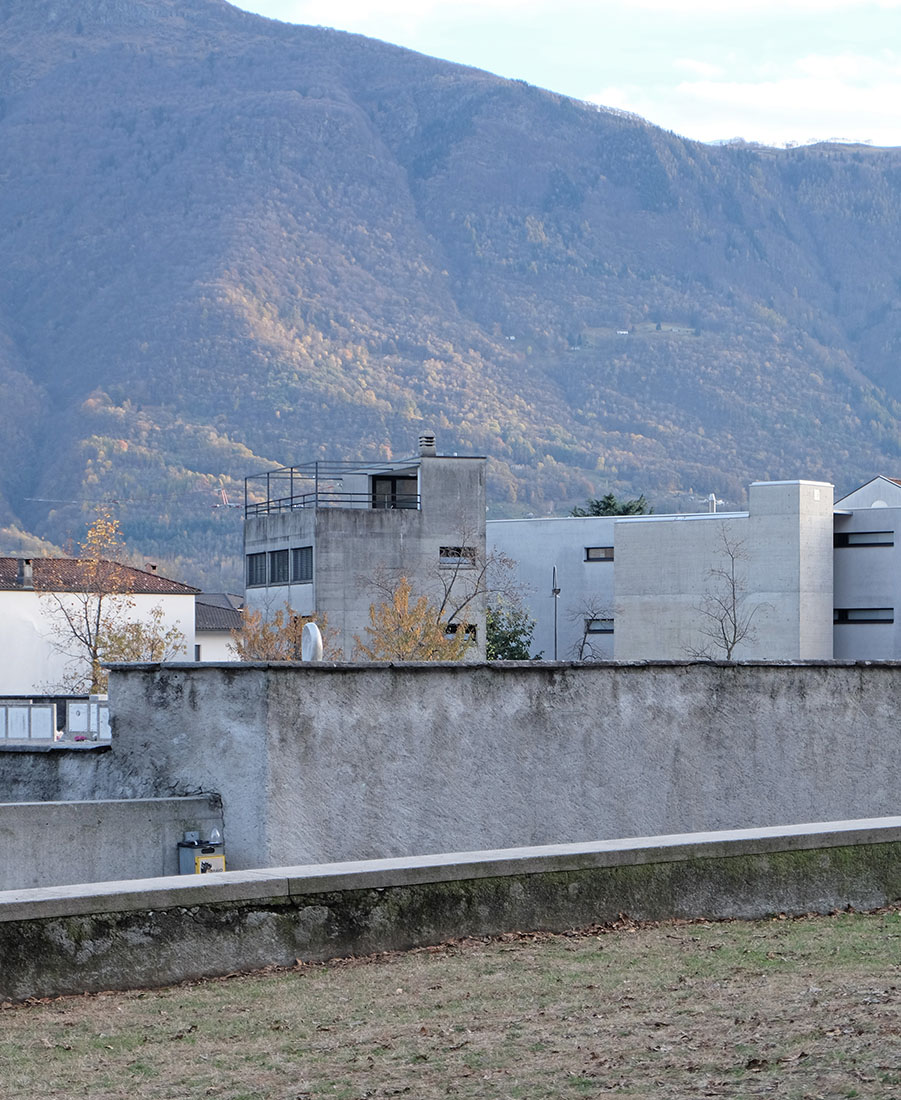 |
 |
 |
 |

Casa del Sindaco
El Cunvént, Monte Carasso
1983 - 1984
As
a tower-like residential building in exposed concrete the
Casa
Guidotti, often referred to as the house of the mayor (Casa
del
Sindaco), marks the place where the ring road changes
direction.
According to the architect Luigi
Snozzi,
the height of the house was intended to emphasize the public
importance
of the structure. The building occupies a special position
in Monte
Carasso, not only because of its modeling as a small tower,
but also
because of its location in a vineyard. This island-like
vineyard in the
middle of the village center is a distinctive feature. The
living and
dining room on the ground floor opens generously
to this garden by
a
two-storey spatial zone. The two-storey zone is continued in
the
outdoor area through a narrow and long terrace. At the other
end of the
property, this terrace ends in a pergola also made of
exposed concrete.
In this way, the interior receives a generous optical
expansion, and
the property is bordered by the built elements. Noteworthy
is the
semicircular balcony on the first floor, which is
superimposed with the
two-storey area of the living room. The balcony is
accessible from a
gallery with a workplace. In addition, the parents' room and
a bathroom
are located on the first floor. On the second floor there
are three
smaller bedrooms and a shower. On the facade, the bedrooms
are
recognizable as a regular array of three horizontal windows.
The last
floor is designed as a spacious roof terrace. Only the
staircase goes
up to this floor. Towards the vineyard the volumetry of this
floor is
indicated by a metal construction. To the opposite side, the
terrace is
defined by slabs of exposed concrete and a ceiling strip.
The plan of
the Casa Guidotti is strictly divided into two zones over
all storeys.
The slightly wider zone with the dayrooms is mainly oriented
to the
vineyard, the narrower zone with entrance, stairs and
bathrooms opens
to the opposite side respectively to the street.
Das Haus Guidotti, oft auch als Haus des Bürgermeisters (Casa del Sindaco) bezeichnet, markiert als turmartiges Wohnhaus in Sichtbeton den Ort wo die Ringstrasse die Richtung ändert. Gemäss dem Architekten Luigi Snozzi sollte das Haus durch seine Höhe ganz bewusst die öffentliche Bedeutung betonen. Das Gebäude nimmt nicht nur durch seine Ausbildung als kleiner Turm, sondern auch durch seine Lage in einem Weingarten eine Sonderstellung in Monte Carasso ein. Dieser inselartige Weingarten mitten im Dorfzentrum stellt eine markante Besonderheit dar. Der Wohn- und Essraum im Erdgeschoss öffnet sich über einen zweigeschossigen Bereich grosszügig zu diesem Garten. Die überhöhte Raumzone wird im Aussenraum durch eine schmale und lange Terrasse fortgesetzt. Am anderen Ende des Grundstücks findet diese Terrasse Ihr Ende in einer Pergola aus Sichtbeton. Auf diese Weise erhält der Innenraum eine grosszügige optische Ausdehnung, und das Grundstück wird durch die gebauten Elemente aufgespannt. Bemerkenswert ist der halbrunde Balkon im ersten Obergeschoss, welcher mit dem zweigeschossigen Bereich des Wohnraums überlagert ist. Zugänglich ist der Balkon von einer Galerie mit einem Arbeitsplatz. Zudem befindet sich im ersten Obergeschoss das Elternzimmer und ein Bad. Im zweiten Obergeschoss befinden sich drei kleinere Schlafzimmer und eine Dusche. An der Fassade erscheinen die Zimmer in Form einer regelmässigen Aufreihung von drei horizontalen Fenstern. Das letzte Geschoss ist als grosszügige Dachterrasse ausgebildet. Lediglich die Treppe führt bis auf dieses Geschoss. Zur Seiten des Weingartens wird das Volumen dieses Stockwerks durch eine Metallene Konstruktion nachgezeichnet. Zur gegenüberliegenden Seite ist die Terrasse durch Sichtbeton Scheiben und einen Deckenstreifen gefasst. Über alle Geschosse wird der Grundriss streng in zwei Zonen gegliedert. Die etwas breiter ausgebildete Zone mit den Aufenthaltsräumen ist hauptsächlich auf den Weingarten orientiert, die schmalere Zone mit Eingang, Treppe und Nasszellen öffnet sich zur gegenüberliegenden Seite respektive zur Strasse.
Das Haus Guidotti, oft auch als Haus des Bürgermeisters (Casa del Sindaco) bezeichnet, markiert als turmartiges Wohnhaus in Sichtbeton den Ort wo die Ringstrasse die Richtung ändert. Gemäss dem Architekten Luigi Snozzi sollte das Haus durch seine Höhe ganz bewusst die öffentliche Bedeutung betonen. Das Gebäude nimmt nicht nur durch seine Ausbildung als kleiner Turm, sondern auch durch seine Lage in einem Weingarten eine Sonderstellung in Monte Carasso ein. Dieser inselartige Weingarten mitten im Dorfzentrum stellt eine markante Besonderheit dar. Der Wohn- und Essraum im Erdgeschoss öffnet sich über einen zweigeschossigen Bereich grosszügig zu diesem Garten. Die überhöhte Raumzone wird im Aussenraum durch eine schmale und lange Terrasse fortgesetzt. Am anderen Ende des Grundstücks findet diese Terrasse Ihr Ende in einer Pergola aus Sichtbeton. Auf diese Weise erhält der Innenraum eine grosszügige optische Ausdehnung, und das Grundstück wird durch die gebauten Elemente aufgespannt. Bemerkenswert ist der halbrunde Balkon im ersten Obergeschoss, welcher mit dem zweigeschossigen Bereich des Wohnraums überlagert ist. Zugänglich ist der Balkon von einer Galerie mit einem Arbeitsplatz. Zudem befindet sich im ersten Obergeschoss das Elternzimmer und ein Bad. Im zweiten Obergeschoss befinden sich drei kleinere Schlafzimmer und eine Dusche. An der Fassade erscheinen die Zimmer in Form einer regelmässigen Aufreihung von drei horizontalen Fenstern. Das letzte Geschoss ist als grosszügige Dachterrasse ausgebildet. Lediglich die Treppe führt bis auf dieses Geschoss. Zur Seiten des Weingartens wird das Volumen dieses Stockwerks durch eine Metallene Konstruktion nachgezeichnet. Zur gegenüberliegenden Seite ist die Terrasse durch Sichtbeton Scheiben und einen Deckenstreifen gefasst. Über alle Geschosse wird der Grundriss streng in zwei Zonen gegliedert. Die etwas breiter ausgebildete Zone mit den Aufenthaltsräumen ist hauptsächlich auf den Weingarten orientiert, die schmalere Zone mit Eingang, Treppe und Nasszellen öffnet sich zur gegenüberliegenden Seite respektive zur Strasse.
